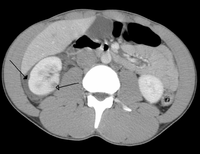
Photo from wikipedia
Abdominal trauma is present in approximately 25% of pediatric patients with major trauma and is the most common cause of unrecognized fatal injury in children. Pediatric abdominal trauma is typically… Click to show full abstract
Abdominal trauma is present in approximately 25% of pediatric patients with major trauma and is the most common cause of unrecognized fatal injury in children. Pediatric abdominal trauma is typically blunt in nature with the spleen being the most common organ injured. Nonoperative management is employed in over 95% of patients. Penetrating injuries are less common but often require operative management. Knowledge of specific mechanisms of injury aids the clinician in the diagnosis of specific injuries. Computed Tomography (CT) is the gold standard in the identification of intra-abdominal injury. Focused Assessment with Sonography for Trauma (FAST) can detect the presence of free fluid suggestive of intra-abdominal injury. In children, the utility of FAST is limited because less than half of pediatric patients with abdominal injury have free fluid. Bowel perforation and pancreatic injuries may not be evident on initial CT scanning of the abdomen. Initial management of the trauma patient in shock includes fluid boluses of normal saline or Ringer's lactate with two, large-bore upper extremity catheters. Transfusion with packed red blood cells is done if the patient remains hypotensive after the second fluid bolus. Emergent laparotomy is indicated in patients with: free intraperitoneal air, hemodynamic instability despite maximal resuscitative efforts (transfusion of greater than 50% of total blood volume), gunshot wound to the abdomen or other penetrating traumas, and evisceration of intraperitoneal contents. Initial FAST followed by abdominal computed tomography is important in the evaluation of the seriously or critically injured patient. The combination of the FAST exam along with selected abdominal computed tomography can further aid in the detection of injuries that may not be clinically apparent.
Journal Title: Current pediatric reviews
Year Published: 2018
Link to full text (if available)
Share on Social Media: Sign Up to like & get
recommendations!